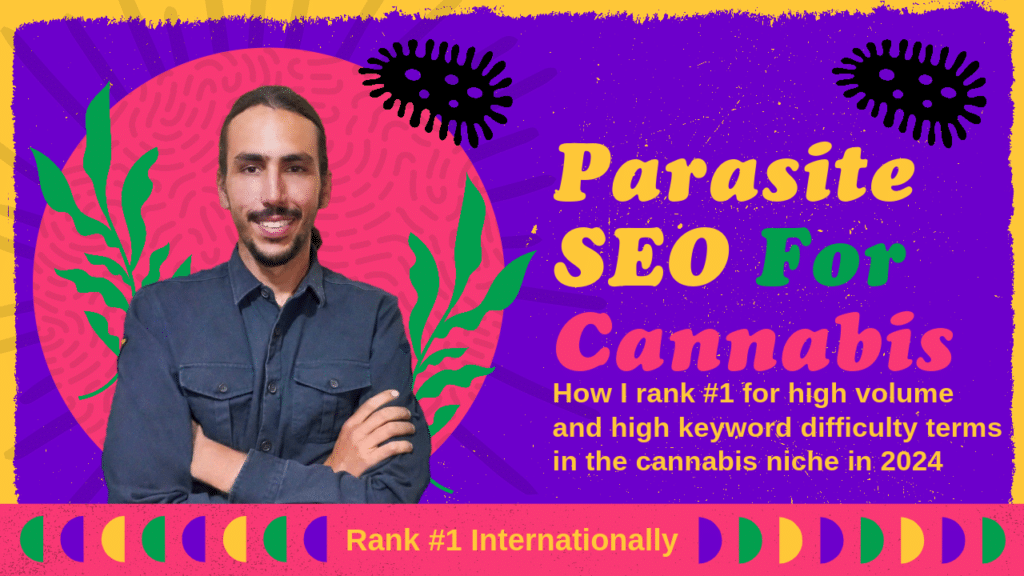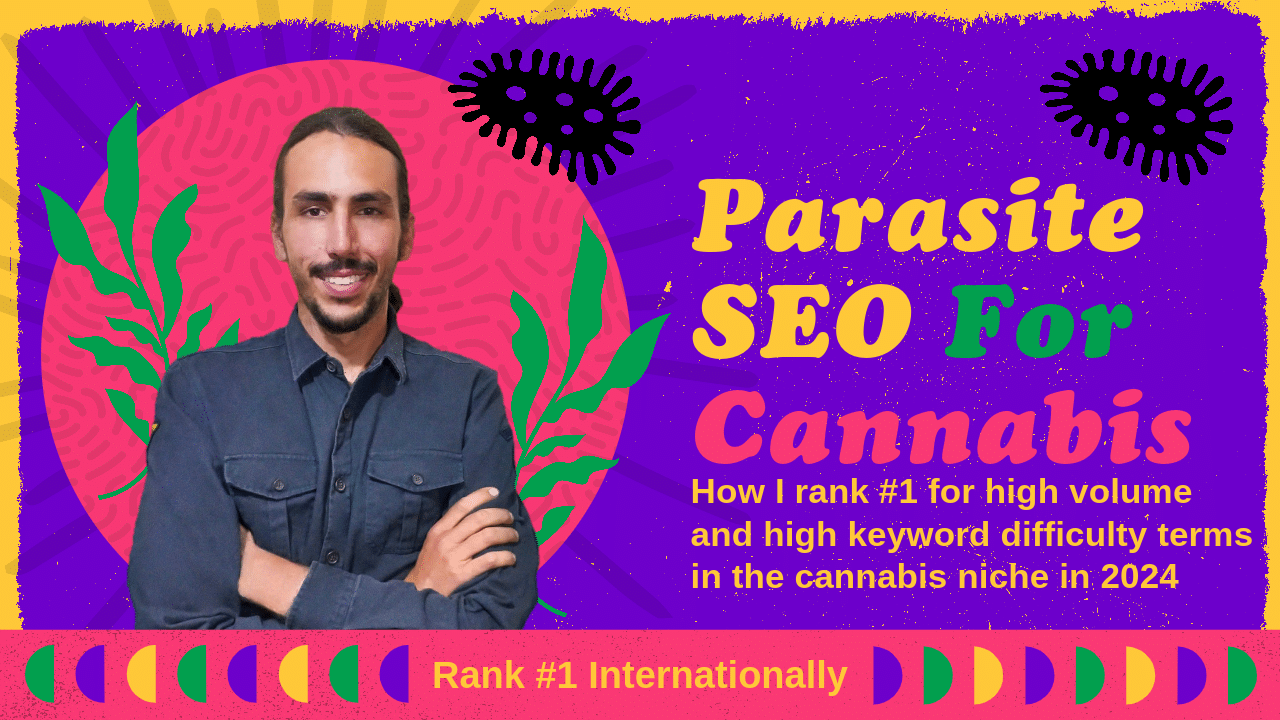Are you looking for a way to rank higher in search engines for your cannabis-related keywords? Do you want to take advantage of the growing demand for cannabis products and services in 2024? If so, you might want to consider using parasite SEO as part of your dispensary marketing plan.
Parasite SEO is a technique that involves publishing your content on high-authority websites that already have a lot of traffic and trust from Google. By doing so, you can leverage their domain authority and popularity to rank faster and easier for your target keywords. You can also drive more referral traffic to your own website, increase your brand awareness, and generate more leads and sales.
On this page, we will show you how to use parasite SEO effectively for your cannabis business in 2024. We will cover the following topics:
- How to find suitable websites for parasite SEO
- How to conduct keyword research for parasite SEO
- How to optimize your content for parasite SEO
- How to create unique graphics for parasite SEO
- How to optimize your headers, slugs, and title tags for parasite SEO
- How to cloak your affiliate links for parasite SEO
- How to acquire backlinks for parasite SEO
- How to maintain content freshness for parasite SEO
>> Book a Free Parasite SEO in Cannabis Consultation
How to Find Suitable Websites for Parasite SEO

The first step of parasite SEO is to find websites that allow you to publish your content on their platform. These websites should have the following characteristics:
- High domain authority and organic traffic
- Relevant to your niche and audience
- Accept guest posts, sponsored posts, or user-generated content
- Allow you to include links to your own website or affiliate offers
Some examples of websites that meet these criteria are:
- News Websites: A parasite SEO strategy that works with the most success typically is done when the content is posted on a news website in the cannabis niche.
- Medium: A popular online publishing platform that covers various topics and niches. You can create your own account and publish your content for free. You can also join publications that are related to your niche and submit your content to them.
- Quora: A popular question-and-answer website that attracts millions of visitors every month. You can create your own profile and answer questions that are related to your niche. You can also include links to your own website or affiliate offers in your answers.
- Reddit: A popular social media platform that consists of thousands of communities or subreddits that cover various topics and niches. You can create your own account and join subreddits that are related to your niche. You can also post your content or links to your own website or affiliate offers in these subreddits.
- YouTube: A popular video-sharing platform that has billions of views every day. You can create your own channel and upload videos that are related to your niche. You can also include links to your own website or affiliate offers in your video descriptions or annotations.
These are just some of the examples of websites that you can use for parasite SEO. You can also look for other websites that are relevant to your niche and audience, such as blogs, news sites, forums, directories, etc.
>> Book a Free Parasite SEO in Cannabis Consultation
How to Conduct Keyword Research for Parasite SEO

The next step of parasite SEO is to conduct keyword research to find the best keywords to target for your content. Keyword research is the process of finding and analyzing the words and phrases that your potential customers use to search for information, products, or services related to your niche.
Keyword research is important for parasite SEO because it helps you to:
- Understand the search intent and needs of your audience
- Find low-competition and high-volume keywords that are easier to rank for
- Optimize your content for the keywords that your audience is searching for
- Measure the performance and effectiveness of your content
Tools for Keyword Research
There are many tools that you can use for keyword research such as Google Keyword Planner, Ubersuggest, Ahrefs, and more. These tools can help you to:
- Generate keyword ideas based on your seed keywords, competitors, or niche
- Analyze the keyword difficulty, search volume, and trends of your keywords
- Find related keywords, long-tail keywords, and question keywords
- Discover the content and backlink strategies of your competitors
For example, if you want to target the keyword “cannabis dispensary”, you can use Ubersuggest to find out the following information:
- The keyword difficulty is 38, which means it is moderately competitive
- The search volume is 74,000, which means it has a high demand
- The trend is stable, which means it has a consistent interest
- The related keywords are “cannabis dispensary near me”, “cannabis dispensary license”, “cannabis dispensary jobs”, etc.
- The question keywords are “how to open a cannabis dispensary”, “how much does a cannabis dispensary make”, “how to get a cannabis dispensary license”, etc.
- The top ranking pages are from Weedmaps, Leafly, Potguide, etc.
Based on this information, you can decide whether to target this keyword or not, and how to optimize your content for it. You can also use other tools to find more keyword ideas and data.
>> Book a Free Parasite SEO in Cannabis Consultation
How to Optimize Your Content for Parasite SEO

The third step of parasite SEO is to optimize your content for the keywords that you have chosen. Content optimization is the process of improving the quality, relevance, and structure of your content to make it more appealing and useful for your audience and search engines.
Content optimization is important for parasite SEO because it helps you to:
- Provide valuable and engaging information to your audience
- Increase the click-through rate and dwell time of your content
- Improve the ranking and visibility of your content in search engines
- Boost the conversion rate and revenue of your content
Factors to Consider When Optimizing Your Content
There are many factors that you need to consider when optimizing your content, such as:
- Content length: Your content should be long enough to cover the topic in depth and provide comprehensive information to your audience. Generally, longer content tends to rank better than shorter content, but the optimal length may vary depending on the keyword, niche, and platform. You can use tools like Surfer SEO11 to analyze the ideal content length for your keyword and platform.
- Content format: Your content should be formatted in a way that makes it easy to read and understand for your audience and search engines. You should use headings, subheadings, bullet points, lists, tables, charts, images, videos, etc. to break up your content and highlight the main points. You should also use white space, font size, color, and contrast to improve the readability and aesthetics of your content.
- Content quality: Your content should be original, accurate, relevant, and up-to-date. You should avoid plagiarism, grammar errors, spelling mistakes, factual errors, outdated information, etc. that can harm your credibility and reputation. You should also provide sources, references, citations, etc. to support your claims and arguments. You can use tools like Grammarly12 and Copyscape13 to check the quality and originality of your content.
- Content relevance: Your content should be relevant to the keyword, topic, and niche that you are targeting. You should use the keyword and its variations naturally and strategically throughout your content, especially in the title, introduction, conclusion, headings, and subheadings. You should also use semantic keywords, related keywords, and question keywords that are relevant to your keyword and topic. You can use tools like Yoast SEO14 to check the relevance and optimization of your content.
>> Book a Free Parasite SEO in Cannabis Consultation
How to Create Unique Graphics for Parasite SEO

The fourth step of parasite SEO is to create unique graphics for your content. Graphics are visual elements that can enhance the appeal, engagement, and effectiveness of your content. They can include images, videos, infographics, charts, diagrams, illustrations, etc.
Graphics are important for parasite SEO because they can help you to:
- Attract and retain the attention of your audience
- Explain and simplify complex or abstract concepts
- Provide additional or complementary information to your content
- Increase the shareability and virality of your content
- Improve the ranking and visibility of your content in search engines
Strategies For Creating Unique Graphics
There are many ways that you can create unique graphics for your content, such as:
- Using your own photos or videos: You can use your own camera or smartphone to take photos or videos that are related to your content. For example, if you are writing about cannabis strains, you can take photos or videos of the different strains that you are reviewing or recommending. This can make your content more authentic and trustworthy.
- Using stock photos or videos: You can use stock photos or videos that are available online for free or for a fee on sites like Unsplash, Pixabay, Pexels, Shutterstock, etc. You should always check the license and attribution requirements of the stock photos or videos that you use.
- Using graphic design tools: You can use graphic design tools to create your own graphics from scratch or using templates. You can create graphics related to your content using tools like Canva, Adobe Spark, Visme, etc. You can also use tools like graphic_art(“a cannabis leaf”) to generate graphical artwork based on your prompt.
- Using data visualization tools: You can use data visualization tools to create graphics that display data or information in a visual way. You can create graphics that are related to your content using tools like Google Charts, Infogram, Chart.js, and more.
>> Book a Free Parasite SEO in Cannabis Consultation
How to Optimize Your Headers, Slugs, and Title Tags for Parasite SEO

The fifth step of parasite SEO is to optimize your headers, slugs, and title tags for your content. Headers, slugs, and title tags are elements that appear in the search engine results pages (SERPs) and on the web pages that display your content. They can influence the click-through rate, ranking, and relevance of your content.
Headers, slugs, and title tags are important for parasite SEO because they can help you to:
- Catch the attention and interest of your audience
- Communicate the main idea and value proposition of your content
- Include your target keyword and its variations
- Match the search intent and expectations of your audience
- Improve the user experience and navigation of your content
Best Practices for Metatag Optimization
There are some best practices that you need to follow when optimizing your headers, slugs, and title tags, such as:
- Headers: Headers are the headings and subheadings that divide your content into sections and subsections. You should use the H1 tag for the main heading of your content, and the H2, H3, H4, etc. tags for the subheadings. You should include your target keyword and its variations in your headers, especially in the H1 and H2 tags. You should also use descriptive and catchy headers that summarize the main points of your content and entice your audience to read more.
- Slugs: Slugs are the parts of the URL that identify the specific page or post on a website. You should use short and simple slugs that include your target keyword and its variations. You should also use hyphens to separate the words in your slugs and avoid using stop words, numbers, symbols, etc. that can make your slugs longer and harder to read.
- Title tags: Title tags are the titles that appear in the SERPs and on the web pages that display your content. You should use compelling and concise title tags that include your target keyword and its variations. You should also use modifiers, such as numbers, adjectives, brackets, etc. that can make your title tags more appealing and specific. You should also keep your title tags within 60 characters to avoid truncation in the SERPs.
What Optimized H1, H2, H3, etc, Tags Look Like
For example, if you are writing a post about the best cannabis strains for anxiety, you can use the following headers, slugs, and title tags:
- H1: The Best Cannabis Strains for Anxiety in 2024
- H2: What is Anxiety and How Can Cannabis Help?
- H2: How to Choose the Right Cannabis Strain for Anxiety
- H3: Indica vs Sativa vs Hybrid: Which One is Better for Anxiety?
- H3: THC vs CBD: Which One is More Effective for Anxiety?
- H3: The Top 10 Cannabis Strains for Anxiety in 2024
- Slug: best-cannabis-strains-for-anxiety
- Title tag: The Best Cannabis Strains for Anxiety in 2024 [Updated]
>> Book a Free Parasite SEO in Cannabis Consultation
How to Cloak Your Affiliate Links for Parasite SEO

The sixth step of parasite SEO is to cloak your affiliate links for your content. Affiliate links are links that direct your audience to a product or service that you are promoting or recommending in exchange for a commission. Cloaking affiliate links is the process of hiding or disguising the original URL of the affiliate link to make it look more natural and trustworthy.
Cloaking affiliate links is important for parasite SEO because it can help you to:
- Avoid spam filters and penalties from search engines and platforms
- Increase the click-through rate and conversion rate of your affiliate links
- Protect your affiliate links from theft or hijacking
- Track and measure the performance and revenue of your affiliate links
How to Cloak Affiliate Links
There are many ways that you can cloak your affiliate links, such as:
- Using URL shorteners: You can use URL shorteners to create shorter and simpler URLs that replace the original affiliate link. You can use URL shorteners like Bitly, TinyURL, Rebrandly, etc. to create and manage your cloaked affiliate links.
- Using redirects: You can use redirects to create URLs that point to your own domain and then redirect to the original affiliate link. You can use redirects like 301, 302, or 307 to create and manage your cloaked affiliate links. You can also use plugins like Pretty Links, ThirstyAffiliates, or Easy Affiliate Links to create and manage your cloaked affiliate links on WordPress.
- Using cloaking tools: You can use cloaking tools to create URLs that hide the original affiliate link and display a different URL or content to the user and the search engine. You can use cloaking tools like LinkTrackr, ClickMagick, or Voluum to create and manage your cloaked affiliate links.
For example, if you are promoting a cannabis product from Amazon, you can use the following methods to cloak your affiliate link:
- Original affiliate link: https://www.amazon.com/gp/product/B08L5ZP1N9/ref=as_li_tl?ie=UTF8&camp=1789&creative=9325&creativeASIN=B08L5ZP1N9&linkCode=as2&tag=yourtag-20&linkId=1234567890
- URL shortener: https://bit.ly/3uXyZt4
- Redirect: https://yourdomain.com/recommends/cannabis-product
- Cloaking tool: https://track.yourdomain.com/cannabis-product
>> Book a Free Parasite SEO in Cannabis Consultation
How to Acquire Backlinks for Parasite SEO

The seventh step of parasite SEO is to acquire backlinks for your content. Backlinks are links that point to your content from other websites. They can improve the authority, popularity, and relevance of your content in search engines and platforms.
Backlinks are important for parasite SEO because they can help you to:
- Increase the traffic and exposure of your content
- Improve the ranking and visibility of your content in search engines and platforms
- Boost the trust and credibility of your content and brand
- Generate more leads and sales from your content
>> Book a Free Parasite SEO in Cannabis Consultation
Tips For Acquiring Backlinks in the Cannabis Niche
There are many ways that you can acquire backlinks for your content, such as:
- Guest posting: Guest posting is the process of writing and publishing your content on other websites that are related to your niche and audience. You can include a link to your content or website in your author bio or within your content. You can find guest posting opportunities by searching for keywords like “write for us”, “guest post”, “contribute”, etc. in Google or using tools like Guest Post Tracker, Ninja Outreach, or Pitchbox.
- Skyscraper technique: Skyscraper technique is the process of finding and improving the existing content that ranks well for your target keyword and then reaching out to the websites that link to that content and asking them to link to your content instead. You can find and improve the existing content by using tools like Ahrefs, Ubersuggest, or Surfer SEO. You can also reach out to the websites that link to that content by using tools like Hunter, Mailshake, or Lemlist.
- Broken link building: Broken link building is the process of finding and fixing the broken links on other websites that are related to your niche and audience and then asking them to link to your content instead. You can find and fix the broken links by using tools like Ahrefs, Ubersuggest, or Check My Links. You can also reach out to the websites that have the broken links by using tools like Hunter, Mailshake, or Lemlist.
- HARO: HARO stands for Help A Reporter Out, which is a service that connects journalists and bloggers with sources and experts. You can sign up for HARO and receive daily emails with queries from journalists and bloggers who are looking for sources and experts for their stories. You can respond to the queries that are related to your niche and expertise and include a link to your content or website in your response.
These are just some of the examples of ways that you can acquire backlinks for your content. You can also look for other ways that are relevant to your niche and audience, such as testimonials, reviews, interviews, podcasts, webinars, etc.
>> Book a Free Parasite SEO in Cannabis Consultation
How to Maintain Content Freshness

The eighth and final step of parasite SEO is to maintain content freshness for your content. Content freshness is the measure of how up-to-date, relevant, and accurate your content is. It can affect the ranking, visibility, and performance of your content in search engines and platforms.
Content freshness is important for parasite SEO because it can help you to:
- Provide the latest and best information to your audience
- Keep your audience engaged and loyal to your content and brand
- Avoid losing traffic and ranking to your competitors
- Increase the authority and trustworthiness of your content and brand
Tips for Maintaining Content Freshness
There are some best practices that you need to follow when maintaining content freshness, such as:
- Updating your content regularly: You should update your content regularly to reflect the changes and trends in your niche and industry. You should add, remove, or modify the information, data, facts, statistics, examples, etc. that are relevant to your content and audience. You should also update the date and time of your content to show when it was last updated.
- Repurposing your content: You should repurpose your content to create new and different formats and versions of your content. You should create content that suits the preferences and needs of your audience and the platforms that you are using. You can repurpose your content by creating videos, podcasts, infographics, slides, ebooks, etc. from your existing content.
- Promoting your content: You should also promote your content to increase the exposure and reach of your content. You should share your content on social media platforms, such as Facebook, Twitter, Instagram, LinkedIn, etc. You should also use hashtags, keywords, tags, captions, etc. to optimize your content for the platforms and the audience. You should also engage with your audience by responding to their comments, questions, feedback, etc. You can also use tools like Buffer, Hootsuite, or CoSchedule to schedule and manage your social media posts.
Need Some Help Mastering Parasite SEO in Cannabis?

If you are ready to get started with parasite SEO in cannabis, you likely already see the massive amount of skills needed to rank #1 and retain that rank. If you would rather let an experienced team of professionals with vast experience ranking for your target terms, get in touch with us today.


